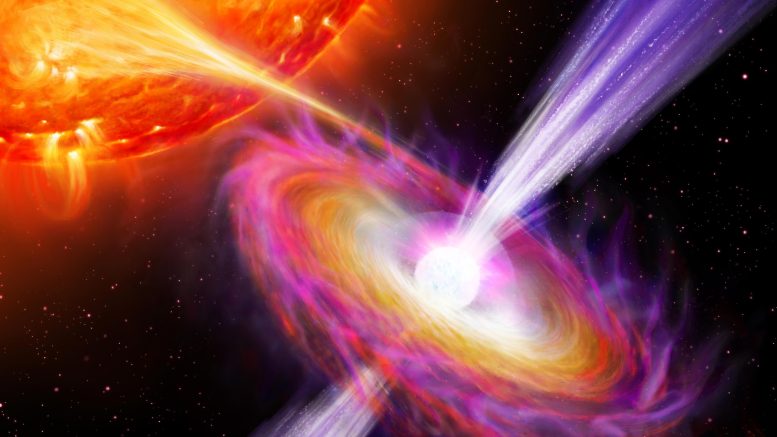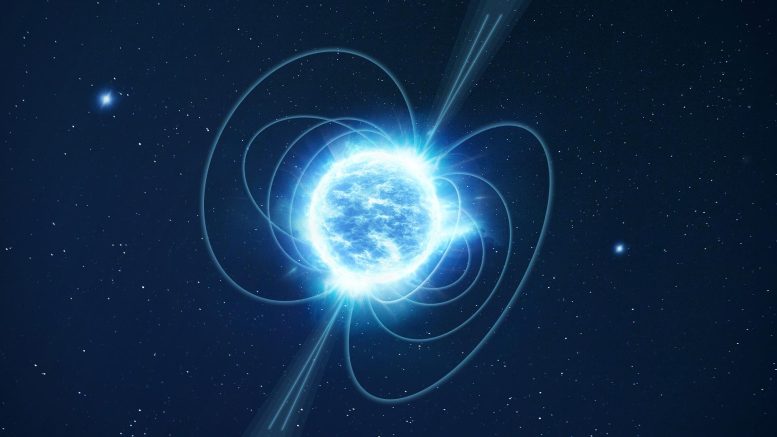

This artist’s impression depicts how nuclear explosions on a neutron star feed the jets blasting off from its magnetic polar regions. Credit: Danielle Futselaar and Nathalie Degenaar, Anton Pannekoek Institute, University of Amsterdam
ESA’s gamma-ray space telescope Integral has played a decisive role in capturing jets of matter being expelled into space at one-third the speed of light. The material and energy were liberated when huge explosions occurred on the surface of a neutron star. This world-first observation proved to be ‘a perfect experiment’ for exploring astrophysical jets of all descriptions.
Jets are produced by many different astronomical objects but studying them is hard. These streams of matter are distant and seeing features in them is challenging. This makes it extremely difficult to trace matter moving along their lengths to understand how the jet is being launched and accelerated.
However, an international team of astronomers including Thomas Russell, National Institute for Astrophysics, INAF, Palermo, Italy, realized that certain types of neutron stars might be open to a new avenue of investigation.


Besides black holes, neutron stars are among the most baffling objects in the Universe. A neutron star is formed in the last moments of the life of a very large star (with more than about eight times the mass as our Sun), when the nuclear fuel in its core eventually runs out. In a sudden and violent end, the outer layers of the star are ejected with monstrous energy in a supernova explosion, leaving behind spectacular clouds of interstellar material rich in dust and heavy metals. At the center of the cloud (nebula), the dense stellar core further contracts to form a neutron star. A black hole can also form when the remaining core’s mass is greater than about three solar masses. Credit: ESA
Neutron stars are super-compact stellar corpses. When in orbit with another star, the neutron star’s intense gravitational field can end up pulling matter from its companion star. Part of this accreted matter is then somehow ejected out into jets that race away along the neutron star’s rotation axis, and the rest of the matter spirals down onto the neutron star. There, it accumulates as a layer on the surface. As more and more material rains down onto the neutron star, the gravitational field compresses it until a runaway nuclear explosion is initiated. This creates a cataclysmic event known as a type-I X-ray burst.
The team reasoned that this sudden liberation of matter and energy from the surface of the neutron star would affect the jet, and that they could measure this disturbance as it propagated outwards. If so, it would provide a powerful new method for studying these violent and energetic events. We currently know of around 125 neutron stars that behave in this way.
“This basically gives us a perfect experiment,” says Thomas. “We have a very brief short-lived impulse of extra material that gets shot into the jet and that we can track as it moves down the jet to learn about its speed.”
On the Hunt
This is a crucial measurement because once enough accreting neutron stars have been studied, the jet speed can reveal the dominant launching mechanism and show whether the jet is powered by magnetic fields anchored in the accreting material, or in the star itself. The team identified two neutron stars, called 4U 1728-34 and 4U 1636-536 respectively, that showed X-ray bursting behavior. However, only 4U 1728-34 proved to be bright enough at radio wavelengths at the time to carry out the experiment in the necessary detail.
Then there was a practical problem. While the explosions were visible in X-rays, the jet only gave out radio waves. So, the team needed to coordinate radio telescope observations on Earth to take place simultaneously with those of the Integral satellite, which is able of seeing in X-rays. But, it was impossible to predict exactly when one of these explosions was going to take place.
“These bursts reoccur every couple of hours, but you can’t predict exactly when they will happen. So, you have to stare at the system for a long time with the telescopes, and hope you catch a couple of bursts,” says team member Jakob van den Eijnden, University of Warwick, UK.
The radio observations were taken over three days with CSIRO’s Australia Telescope Compact Array (ATCA), logging a total of around 30 hours of observing time between 3–5 April 2021. Integral observed from space. It was the only high-energy mission capable of maintaining this long vigil. Its large, elongated orbit meant that it could stare at the celestial object for many hours at a time. At the end of the observations, Integral had captured 14 X-ray bursts from 4U 1728-34, of which 10 occurred when the source was visible to the ATCA.
But there was a big surprise. “Based on what we had seen previously in X-ray data, we thought that the explosion would destroy the location where the jet was being launched. But we saw exactly the opposite: a strong input into the jet rather than a disruption,” says team member Nathalie Degenaar, University of Amsterdam, the Netherlands.
Clearly, the jet mechanism was more robust than thought. Being able to follow the injected extra matter down the jet at radio wavelengths allowed the team to calculate that the material was being launched at an incredible 35-40% the speed of light.
“Never before have we been able to anticipate and directly watch how a certain amount of gas got channeled into a jet and accelerated into space,” says team member Erik Kuulkers, ESA project scientist.
A New Method for Studying Jets
Having now proved that this is possible, the technique will allow astronomers to study many more X-ray bursting neutron stars. This will help them understand and connect the launching of jets to specific characteristics of neutron stars, such as their rotation rate and the amount of gas falling onto their surface. For those studying such phenomena, these are the pressing questions. Answering them will impact studies beyond neutron stars because jets are created by many astronomical objects.
From newly formed stars to supermassive black holes in the centers of galaxies, jets can also be produced by cataclysmic events such as supernova explosions and gamma-ray bursts. They play an important role throughout the Universe, from transporting exotic elements synthesized in cosmic explosions into interstellar space, to heating surrounding gas clouds that will alter how and where new stars can form.
Because all astrophysical jets are thought to be launched in similar ways, namely by the interplay of matter with magnetic fields in rotating celestial objects, the new results will have wide applicability in many studies of the cosmos. “This result is opening a completely new window to understanding how astrophysical jets are powered up, in neutron stars and also in other jet-producing astronomical objects,” says Erik.
Reference: “Thermonuclear explosions on neutron stars reveal the speed of their jets” by Thomas D. Russell, Nathalie Degenaar, Jakob van den Eijnden, Thomas Maccarone, Alexandra J. Tetarenko, Celia Sánchez-Fernández, James C. A. Miller-Jones, Erik Kuulkers and Melania Del Santo, 27 March 2024, Nature.
DOI: 10.1038/s41586-024-07133-5

